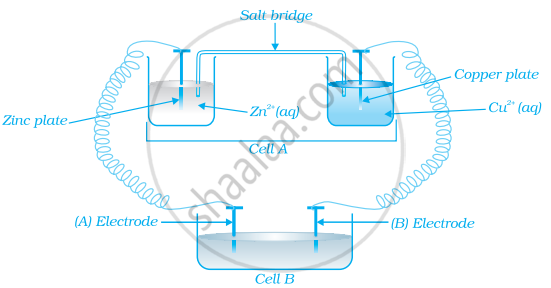Advertisements
Advertisements
प्रश्न
Calculate emf of the following cell at 25°C:
\[\ce{Sn/Sn^2+ (0.001 M) || H+ (0.01 M) | H2_{(g)} (1 bar) | Pt_{(s)}}\]
Given: \[\ce{E^\circ(Sn^2+/sn) = -0.14 V, E^\circ H+/H2 = 0.00 V (log 10 = 1)}\]
उत्तर
According to Nernst equation,
`E_"cell"=E_(cell)^0-0.0592/nlog"" ([P])/([R])`
`E_(cell)^0=E_("Oxi(anode)")^0-E_("Oxi(cathode)")^0`
= − 0.14 − 0.0
= −0.14
Reactions:
Anode (oxidation): \[\ce{Sn(s) -> Sn^2+(aq) + 2e^−}\]
Cathode (reduction): \[\ce{2H+(aq) + 2e− -> H2(g)}\]
Net reaction: \[\ce{Sn(s) + 2H+(aq) -> Sn^2+(aq) + H2(g)}\]
∴ n = 2
\[\ce{[P] = [Sn^2+] = 0.001 M}\]
\[\ce{[R] = [H+] = 0.01 M}\]
So, putting the above values in the formula,
`E_(cell) = -0.14 - 0.0592/2 log([0.001])/([0.01]^2)`
Ecell = −0.1696 V
APPEARS IN
संबंधित प्रश्न
Arrange the following reducing agents in the order of increasing strength under standard state conditions. Justify the answer
|
Element |
Al(s) |
Cu(s) |
Cl(aq) |
Ni(s) |
|
Eo |
-1.66V |
0.34V |
1.36V |
-0.26V |
Can copper sulphate solution be stored in an iron vessel? Explain.
The standard e.m.f of the following cell is 0.463 V
`Cu|Cu_(1m)^(++)`
What is the standard potential of Cu electrode?
(A) 1.137 V
(B) 0.337 V
(C) 0.463 V
(D) - 0.463 V
Calculate E°cell for the following reaction at 298 K:
2Al(s) + 3Cu+2(0.01M) → 2Al+3(0.01M) + 3Cu(s)
Given: Ecell = 1.98V
Calculate emf of the following cell at 25 °C :
Fe|Fe2+(0.001 M)| |H+(0.01 M)|H2(g) (1 bar)|Pt (s)
E°(Fe2+| Fe)= −0.44 V E°(H+ | H2) = 0.00 V
Draw a neat and labelled diagram of the lead storage battery.
The difference between the electrode potentials of two electrodes when no current is drawn through the cell is called ______.
Value of standard electrode potential for the oxidation of \[\ce{Cl-}\] ions is more positive than that of water, even then in the electrolysis of aqueous sodium chloride, why is \[\ce{Cl-}\] oxidised at anode instead of water?
Assertion: Cu is less reactive than hydrogen.
Reason: `E_((Cu^(2+))/(Cu))^Θ` is negative.
Consider the figure and answer the following question.
If cell ‘A’ has ECell = 0.5V and cell ‘B’ has ECell = 1.1V then what will be the reactions at anode and cathode?
